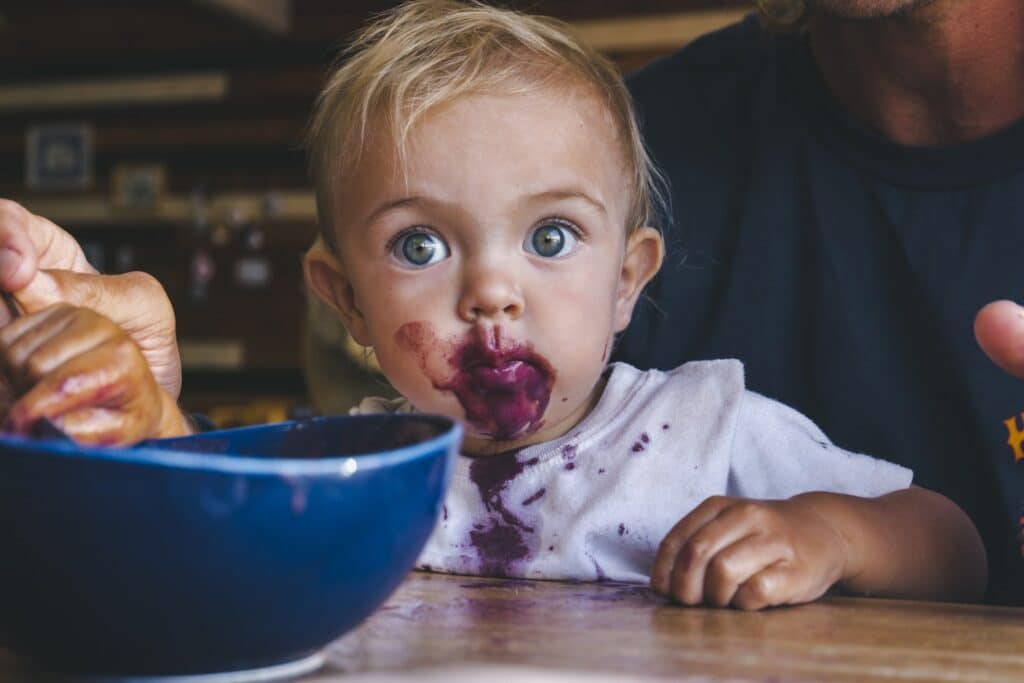As a pediatric feeding and swallowing specialist, I often find I have to teach parents how and why they should say “yes to the mess.” I even threaten to make a poster that says, “Say yes to the Mess!” and hang it in their kitchen! I haven’t actually hung one up yet, but never say never! I was asked to write this blog because oftentimes, we, as parents (and therapists), think we are doing good by teaching our kiddos how to not make a mess when they are eating, but, what we often don’t realize is that we are actually limiting our kiddos ability to experience food in a non-threatening way.
A child’s job is to play and, guess what? They LEARN through play. Learning through play does not only mean playing with toys. It means allowing your child to play with food, too. Why is this important? It is important because eating is one of the most complex activities we do as humans. It involves ALL of our senses-sight, smell, touch, sound, and taste and even our “hidden sense” of proprioception as we grade how much force to use when grasping food. There are 2 other “hidden senses” in addition to proprioception (vestibular, interoceptive) that are also involved, but we can save talking about those in more detail for another day. By allowing your child opportunities to play with and explore a variety of foods, the more you are EXPOSING them to the sensory aspects of the food. Over time, EXPOSURE leads to ACCEPTANCE.
Exposure is a word I use a lot when talking to my families about their child’s feeding challenges. The more opportunities to play with and/or explore foods that we provide to our children, the more they get accustomed to the sensory properties of that food. Again, think about how the food looks, smells, feels like, sounds like, and tastes. By exposing your child to a variety of foods in a playful way, you are helping your child to exercise their sensory systems. Think about a bodybuilder. He did not become strong overnight. It took hundreds upon hundreds of repeated exercises to get him into the shape he needed to be in to become a bodybuilder. By allowing repeated opportunities for your child to engage in food play/exploration, you are helping your child’s sensory systems to grow and develop so she doesn’t have to over- or under-respond to new foods.
You might say, “but all that play will lead to a lot of clean up!” Playing with food does not have to mean dropping food all over the floor or throwing it against the wall. Strategies such as keeping a damp washcloth handy for clean-up, using a “splat mat” under their seat or highchair, stripping baby down to a diaper before a meal can all help make the clean up process a little easier. Giving small amounts of food at a time is also helpful to limit the amount of food that is dropped when the child is done, while also reducing visual stimulation on their tray.
There are lots of fun food-based activities you and your child can participate in. Think about sorting blueberries, strawberries, and pieces of cantaloupe by color. Or making a tower out of cheese cubes. Use mini cookie cutters to make fun shapes out of food. Food preparation and cooking together are great ways to allow your child to learn about food alongside you. There are many kid-friendly utensils that your child can use to help you prep meals. And, yes, there will be some clean up involved, but that, too, can be an opportunity for further exposure.
So the next time you find yourself ready to tell your child to stop playing with their food, stop and SAY YES TO THE MESS!
Written by Kelly Catapano, MS, CCC-SLP and Sara Periera, OTR/L

